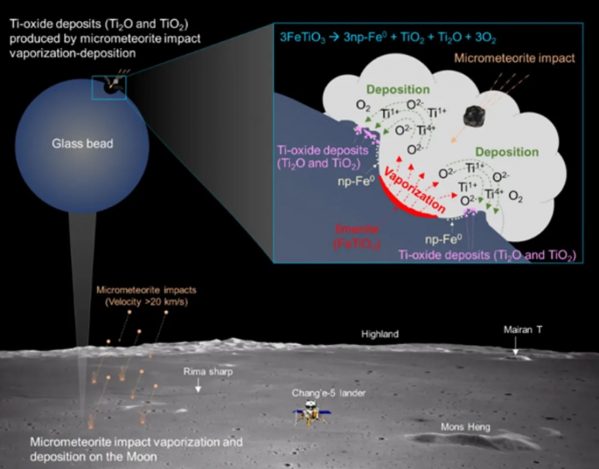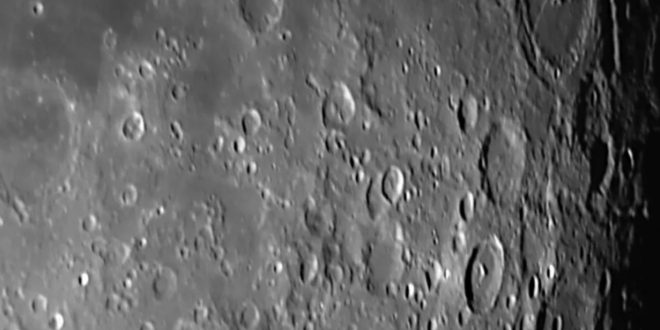The Chang’e-5 Moon mission has discovered two novel minerals composed of titanium and oxygen in lunar samples. These minerals, which are the seventh and eighth to be discovered on the Moon, have never been observed in their natural state on Earth or any other location.
Recent research has uncovered the significance of titanium in relation to the geology and history of the Moon. Titanium on Earth frequently combines with oxygen to create titanium dioxide (TiO2). However, the recent discovery demonstrates that these two elements can also form a bond in the opposite proportion, but seemingly only on the moon.
The team analyzed a glass bead retrieved by Chang’e-5 to investigate the abundance of glass formed as a result of meteorite impacts on the lunar surface. By employing a transmission electron microscope, the researchers discovered that the identical elements were organized in three distinct ways. Rutile is the predominant natural form of titanium dioxide on Earth and is extensively utilized in optical equipment due to its capacity to refract light.
Titanium dioxide can be found in various crystal structures on Earth. However, rather than discovering the expected substances, the team came across Ti2O crystals. The authors use the terms “trigonal” and “triclinic” to describe Ti2O until official names are assigned. These two terms indicate the alterations that occur when titanium-rich minerals are exposed to space bombardment without any protective measures.
Geologists have made significant efforts to determine the formation process of the minerals brought back by the Apollo astronauts, which are not typically found on Earth. The samples underwent exposure to hydrogen and helium ions in order to simulate the solar wind and were subsequently subjected to laser bombardment. This phenomenon results in the formation of novel iron- and silicon-rich minerals. However, despite the high concentration of titanium on the side of the moon that faces Earth, no additional types of minerals containing titanium were discovered, either in the lunar samples or in the simulated experiments.
The issue may have arisen from the failure to address micrometeorites.
As their names suggest, micrometeorites are small in size. The entities accountable for the observed phenomena investigated by the researchers have a size ranging from 1 to 100 μm, which is equivalent to a range of 0.000004 inches to a hundred times smaller. Despite their small size, these objects can achieve high velocities exceeding 20 km/s (45,000 mph) due to the absence of any atmospheric resistance. Upon collision, they have the ability to liquefy the rocks they hit, regardless of their size, or even transform them into vapor. The process of solidification can result in a substance that is significantly distinct from its original form.
The researchers examined a bead that was created by the impact of a meteorite. A micrometeorite created a small crater in this bead, and four irregularly shaped grains with a titanium and oxygen composition are present around the edge of the crater. All of them possess crystal lattices. For certain instances, the ratio of oxygen atoms to titanium atoms is as anticipated, with two oxygen atoms per titanium atom. In other cases, the opposite occurs.

Both the trigonal and triclinic forms of Ti2O have identical elemental ratios, but they exhibit distinct arrangements of atoms.
The grains are minuscule to the point of appearing unimportant; however, the authors observe that titanium oxides in general function as catalysts for numerous reactions when exposed to sunlight. Ti2O exhibits a higher capacity to absorb ultraviolet and visible light compared to TiO2, indicating that it has the potential to be a more potent photocatalyst. Consequently, it is expected to induce notable alterations in the surrounding dust. Although Ti2O does not occur naturally in any earthly structure, it has been synthesized in laboratories for the purpose of creating photocatalytic films.
The samples that Chang’e-5 collected contained a previously undiscovered lunar mineral. The remaining five originated from the Apollo and Luna missions.
The research findings have been published in the esteemed scientific journal Nature Astronomy.
 Tech Gadget Central Latest Tech News and Reviews
Tech Gadget Central Latest Tech News and Reviews



